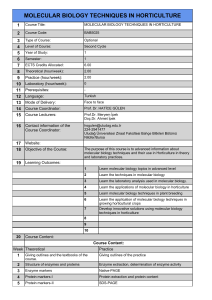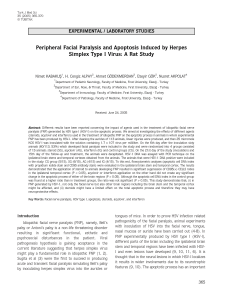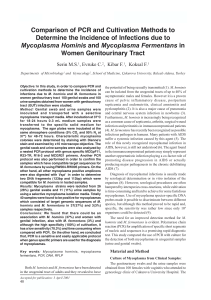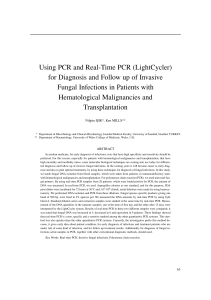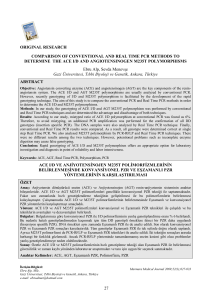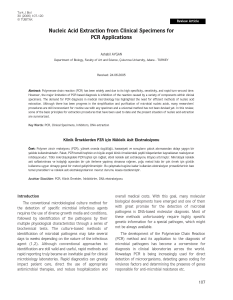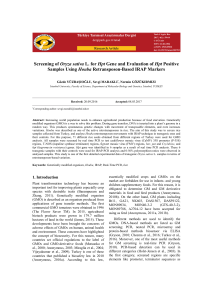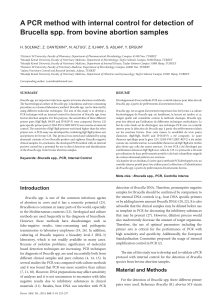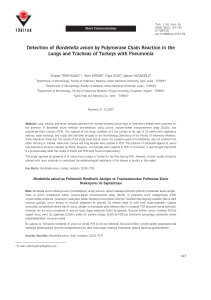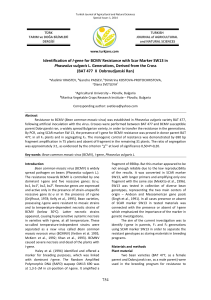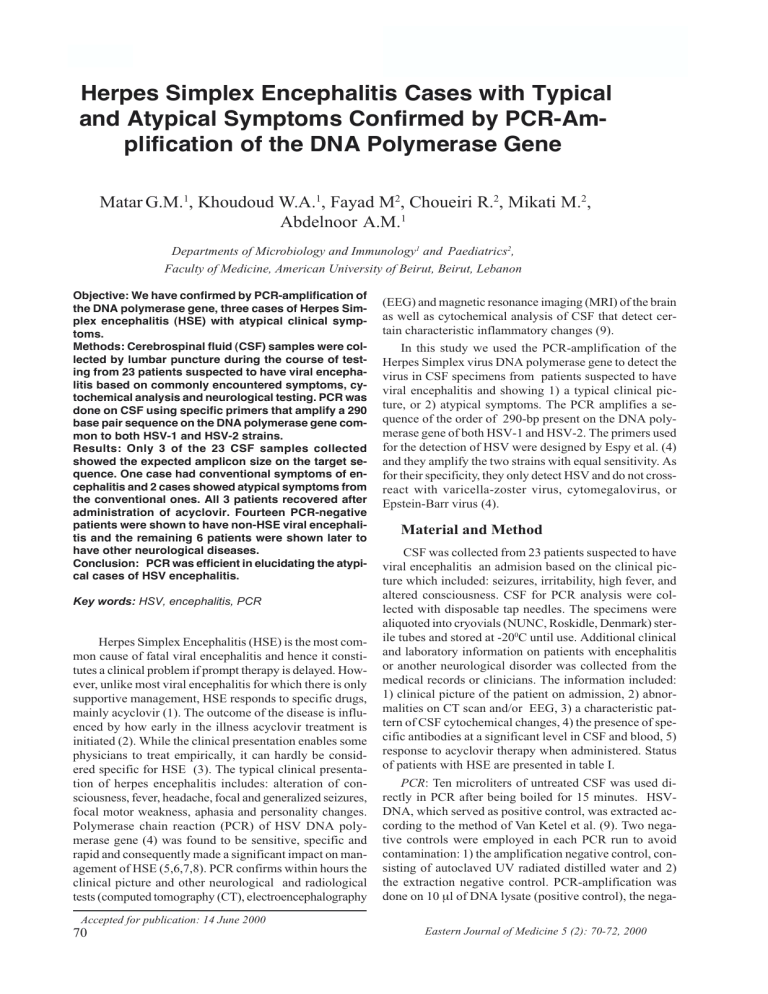
Matar et al.
Herpes Simplex Encephalitis Cases with Typical
and Atypical Symptoms Confirmed by PCR-Amplification of the DNA Polymerase Gene
Matar G.M.1, Khoudoud W.A.1, Fayad M2, Choueiri R.2, Mikati M.2,
Abdelnoor A.M.1
Departments of Microbiology and Immunology1 and Paediatrics2,
Faculty of Medicine, American University of Beirut, Beirut, Lebanon
Objective: We have confirmed by PCR-amplification of
the DNA polymerase gene, three cases of Herpes Simplex encephalitis (HSE) with atypical clinical symptoms.
Methods: Cerebrospinal fluid (CSF) samples were collected by lumbar puncture during the course of testing from 23 patients suspected to have viral encephalitis based on commonly encountered symptoms, cytochemical analysis and neurological testing. PCR was
done on CSF using specific primers that amplify a 290
base pair sequence on the DNA polymerase gene common to both HSV-1 and HSV-2 strains.
Results: Only 3 of the 23 CSF samples collected
showed the expected amplicon size on the target sequence. One case had conventional symptoms of encephalitis and 2 cases showed atypical symptoms from
the conventional ones. All 3 patients recovered after
administration of acyclovir. Fourteen PCR-negative
patients were shown to have non-HSE viral encephalitis and the remaining 6 patients were shown later to
have other neurological diseases.
Conclusion: PCR was efficient in elucidating the atypical cases of HSV encephalitis.
Key words: HSV, encephalitis, PCR
Herpes Simplex Encephalitis (HSE) is the most common cause of fatal viral encephalitis and hence it constitutes a clinical problem if prompt therapy is delayed. However, unlike most viral encephalitis for which there is only
supportive management, HSE responds to specific drugs,
mainly acyclovir (1). The outcome of the disease is influenced by how early in the illness acyclovir treatment is
initiated (2). While the clinical presentation enables some
physicians to treat empirically, it can hardly be considered specific for HSE (3). The typical clinical presentation of herpes encephalitis includes: alteration of consciousness, fever, headache, focal and generalized seizures,
focal motor weakness, aphasia and personality changes.
Polymerase chain reaction (PCR) of HSV DNA polymerase gene (4) was found to be sensitive, specific and
rapid and consequently made a significant impact on management of HSE (5,6,7,8). PCR confirms within hours the
clinical picture and other neurological and radiological
tests (computed tomography (CT), electroencephalography
Accepted for publication: 14 June 2000
70
(EEG) and magnetic resonance imaging (MRI) of the brain
as well as cytochemical analysis of CSF that detect certain characteristic inflammatory changes (9).
In this study we used the PCR-amplification of the
Herpes Simplex virus DNA polymerase gene to detect the
virus in CSF specimens from patients suspected to have
viral encephalitis and showing 1) a typical clinical picture, or 2) atypical symptoms. The PCR amplifies a sequence of the order of 290-bp present on the DNA polymerase gene of both HSV-1 and HSV-2. The primers used
for the detection of HSV were designed by Espy et al. (4)
and they amplify the two strains with equal sensitivity. As
for their specificity, they only detect HSV and do not crossreact with varicella-zoster virus, cytomegalovirus, or
Epstein-Barr virus (4).
Material and Method
CSF was collected from 23 patients suspected to have
viral encephalitis an admision based on the clinical picture which included: seizures, irritability, high fever, and
altered consciousness. CSF for PCR analysis were collected with disposable tap needles. The specimens were
aliquoted into cryovials (NUNC, Roskidle, Denmark) sterile tubes and stored at -200C until use. Additional clinical
and laboratory information on patients with encephalitis
or another neurological disorder was collected from the
medical records or clinicians. The information included:
1) clinical picture of the patient on admission, 2) abnormalities on CT scan and/or EEG, 3) a characteristic pattern of CSF cytochemical changes, 4) the presence of specific antibodies at a significant level in CSF and blood, 5)
response to acyclovir therapy when administered. Status
of patients with HSE are presented in table I.
PCR:Ten microliters of untreated CSF was used directly in PCR after being boiled for 15 minutes. HSVDNA, which served as positive control, was extracted according to the method of Van Ketel et al. (9). Two negative controls were employed in each PCR run to avoid
contamination: 1) the amplification negative control, consisting of autoclaved UV radiated distilled water and 2)
the extraction negative control. PCR-amplification was
done on 10 µl of DNA lysate (positive control), the negaEastern Journal of Medicine 5 (2): 70-72, 2000
Herpes Simplex Encephalitis Cases with Typical...
tive controls, and the boiled CSF (4) in a MiniCycler (MJ
Research, Watertown, Mass., USA). PCR primers, mix and
PCR conditions used were done according to Epsy et al
(4). Reverse transcription PCR (RT-PCR) using universal
primers for enteroviruses were done on all CSF samples
to rule out enteroviral infections (10). Amplicons were
detected after electrophoresis in a 1.5% agarose (Sigma,
St. Louis, Mo.) gel stained with (5mg/ml) ethidium bromide, observed under UV light, and photographed with
type 667 Polaroid films. HSV PCR products were confirmed by Southern hybridization using a digoxygeninlabeled internal probe (4).
Result and Discussion
Our data have shown that 3 of the 23 CSF samples
have HSV-DNA prior to acyclovir treatment resulting in
the expected 290-bp amplicon by PCR. All other patients
were PCR-negative for HSV-DNA. All CSF samples were
negative by RT-PCR using enteroviruses primers. Figure
1 shows a representative amplicon of HSV polymerase
gene amplicon from the CSF of a patient. One case that
was PCR positive for HSV was clinically suggestive of
having HSV encepahlitis (Table I). However, the other 2
cases were suspected of having viral encephalitis, however their symptoms were atypical as compared to the conventional ones and these 2 were PCR positive for HSV
(Table I).
Patient 1 was a ten-year old boy with coma, fever and
Figure 1. HSV DNA polymerase gene amplicons. Lane 1:
123-bp ladder, lane 2: negative control, lane 3: representative HSV DNA polymerase gene amplicon from CSF of a
patient.
right focal seizures; his EEG showed left temporal spikes
and his brain CT scan was normal. His CSF showed lymphocytosis. He responded to acyclovir and now has minimal residual behavioral problems. Patient 2 was a six and
a six months old girl who presented with headache and
vomiting. Her CT scan was normal and her EEG showed
right temporal spikes. Her CSF showed lymphocytosis.
Table I. Status of three patients with Herp Simplex encephalitis
Age
Clinical
picture
CSF analysis
Neurediagnostik
tests
Specific
Ab for
HSV
PCR of
HSV
Response to
acylovir
therapy
Clinical
diagnosis
10 Y
Fever coma
Right focal
seizures
CT scan normal
EEG: Left
temproral
Spikers
ND
Positive
Good
Herpes
Simplex
HerpsSimplex
Encephalitis
Encaphalitis
encephalitis
61/2 Y
Headache
vomiting
Glucose 87 mg/dl
(NI)
Protein 0,67 g/l
(high) 36 WBC (all
lymph)
Glucose 71 mg/dl
(NI) protein 0.63
g/l (high)
96 WBC
(all lymph)
ND
Positive
Good
Good
9Y
Ataxia
lethargy
spasticity
Glucose 76 mg/dl
(NI) protein 0.33
G/l (high)
2 WBC
(all lymph
CT: adema,
multiple areas of
white and gray
matter
hypointsities
MR: Areasof
increased signal
EEG: Slow
bacground, no
paroxysmal
activity
ELISA
ELÝSA
Positive
Good
Eastern Journal of Medicine 5 (2): 70-72, 2000
for HSV
IgG
positive
Herpes Simplex
HerpsSimplex
encephalitis
Encephalitis
Encaphalitis
Herpes Simplex
HerpsSimplex
Encephalitis
Encaphalitis
encephalitis
71
Matar et al.
She improved on acyclovir treatment. Patient 3 was a nineyear old girl with ataxia, lethargy, then coma, one seizure,
but no focal findings. Her EEG showed generalized slowing and her CT scan indicated diffuse brain edema and
multiple areas of white and gray matter hypodensities. Her
CSF showed lymphocytosis. She received acyclovir and
her condition improved markedly. Later in follow-up, her
serum was positive for HSV specific IgG antibodies.
Of the remaining 20 PCR-negative patients, 14 were
diagnosed to have a non-HSV encephalitis, and 6 had other
neurological disorders. These served as negative controls.
Out of the 14 non-HSE cases, who ranged in age between
6 months to 12 years, two of the etiologies of viral encephalitis were known. One patient was diagnosed clinically, along with demonstration of elevated IgM titers by
ELISA, to have Cytomegalovirus encephalitis. The patient showed improved clinical response only when
gancyclovir treatment was given. The other patient had
chicken pox symptoms in addition to encephalitis, and
accordingly the final clinical diagnosis was Varicella encephalitis. In the remaining twelve cases, HSE was not
confirmed by the information reported in the patients
records. They had symptoms of acute viral encephalitis
such as a combination of fever, lethargy, and seizures, with
no specific features for HSE. When available, the neurological test done showed non-specific changes such as nonspecific generalized edema by CT scan of the brain. Six
other patients were confirmed by their clinical records to
have other neurological disorders. These had CNS involvement with leukemia or lymphoma, febrile seizures, brain
malformation, peripheral neurological problems, and tuberculous meningitis.
In conclusion, three cases of HSE, one with typical
and two with atypical clinical spectrum were uncovered
by PCR of the HSV DNA polymerase gene. Detection of
HSV DNA is considered to be associated with viral replication and HSV infection of the CNS (1,2). This indicates
that since these patients harbored the virus as detected by
PCR and responded to acyclovir treatment, the atypical
symptoms they show may have to be considered in future
cases as suggestive of HSE.
The authors would like to thank the University Research Board (URB) and the Faculty of Medicine Medical Practice Plan (MPP) of the American University of
Beirut, Lebanon, for financial support. Thanks are also
due to Mr. Issam Khneisser for technical assistance.
72
References
1. Whitley, R.J: Viral encephalitis. N Engl J Med 323: 242250, 1990.
2. Jeffery, K.J.M. and C.R.M. Bangham: Recent advances in
the laboratory diagnosis of central nervous system infections.
Curr Opin Infect Dis 9: 132-137, 1996.
3. Whitley, R.J. and F. Lakeman: Herpes simplex virus infections of the central nervous system: therapeutic and diagnostic considerations. Clin Infect Dis 20: 414-420, 1995.
4. Espy, M.J., J. Aslanzadeh, and T.F. Smith: PCR detection
of herpes simplex virus DNA sequences in cerebrospinal
fluid, p.332-336. In D.H. Persing, T.F. Smith, F.C. Tenover,
and T.J. White (ed.), Diagnosticmolecular microbiology.
American Society for Microbiology, Washington, D.C. 1993.
5. Powell, K.F., N.E. Anderson, R.W. Frith, et al: Non invasive diagnosis of herpes simplex encephalitis. Lancet 335:
357-358, 1990.
6.
Rowley, A.H., R.J. Whitley, F.D. Lakeman, et al: Rapid detection of herpes-simplex-virus DNA in cerebrospinal fluid
of patients with herpes simplex encephalitis. Lancet 335: 440441, 1990.
7. Domingues, R.B., Tsanaclis, A.M.C., Pannuti, C.S., Mayo,
M.S., and Lakeman, F.D: Evaluation of the range of clinical
presentation of herpes simplex encephalitis by using polymerase chain reaction assay of cerebrospinal fluid samples.
Clin Infect Dis 25:86-91, 1997.
8. Domingues, R.B., Lakeman, F.D., Pannuti, C.S., Fink,
M.C.D., and Tsanaclis, A.M.C.: Advantage of polymerase
chain reaction in the diagnosis of herpes simplex encephalitis: presentation of 5 atypical cases. Scand J Infect Dis 29:229231, 1997.
9. Van Ketel, R.J., B. De Wever, and L. Van Alphen. et al:
Detection of Haemophilus influenzae in cerebrospinal fluids
by polymerase chain reaction DNA amplification. J Med
Microbiol 33:271-276, 1990.
10. Romero, J.R. and Rotbart, H.A : PCR detection of the human enteroviruses, p. 401-406. In D.H. Persing, Smith, T.F.,
Tenover, F.C., and White, T.J. (ed.), Diagnostic Molecular
Microbiology. American Society for Microbiology, Washington, D.C. 1993.
Correspondence to:
Ghassan M. Matar Ph.D.
Alexander M. Abdelnoor Ph.D.
Dept. of Microbiology and Immunology
American University of Beirut
850, Third Avenue
New York, NY 10022
Eastern Journal of Medicine 5 (2): 70-72, 2000

